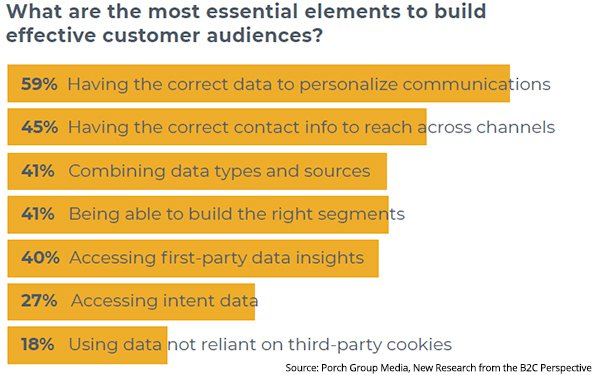Commentary
The Data Lowdown: How B2C Brands Are Building Audiences
- by Ray Schultz , Columnist, May 14, 2024

Two thirds of business-to-consumer (B2C)
marketers are hampered by data challenges, and almost as many feel dissatisfied with the quality of their data.
But B2C marketers are getting better at leveraging information to build customer audiences, judging by 2024 Audience Building: New Research from the B2C Perspective, a study from Porch Group Media, conducted by Ascend2.
For instance, 65% make significant use of first-party data to build their customer audiences, while 29% utilize it to some degree and 65% deploy zero-party data — data willingly shared with the company through surveys or other means.
However, 67% use third-party data, which is not considered optimal, although only 25% utilize it to a significant degree.
At the same time, 53% say they now have strategies in place to reduce their reliance on third-party cookies.
advertisement
advertisement
There are many challenges to building effective customer audiences, including:
- Having the correct data to personalize communications — 57%
- Having the correct contact info to reach across channels — 43%
- Combining data types and sources — 39%
- Being able to build the right segments — 35%
- Accessing intent data — 27%
- Accessing first-party data insights — 25%
- Using data not reliant on third-party cookies — 23%
There are also hurdles to achieving audience segmentation:
- Missing or inaccurate contact data when targeting across channels — 39%
- Data resides in separate and multiple channels — 36%
- Being able to measure segment performance — 36%
- Lack of resources (i.e., personnel, cost) — 35%
- Difficulty accessing the right data to form a comprehensive customer view — 32%
- Inability to keep segments updated — 32%
- Advertise using a consumer ID solution — 27%
But it's worth the trouble. For instance, the respondents have realized these benefits from using first-party data to build their audiences:
- Improved customer experience — 40%
- Increased customer retention — 39%
- Improved ROI on advertising — 36%
- Increased customer engagement — 36%
- Improved targeting accuracy — 36%
- Increased customer acquisition — 34%
- Increased personalization of content — 29%
- Optimized marketing campaigns — 25%
Marketers see these elements as essential to building effective customer audiences:
- Having the correct data to personalize communications — 59%
- Having the correct contact info to reach across channels — 45%
- Combining data types and sources — 41%
- Being able to build the right segments — 41%
- Accessing first-party data insights — 40%
- Accessing intent data — 27%
- Using data not reliant on third-party cookies — 18%
Of the various data sources, brands use these to build their target audiences:
- Website data — 64%
- Social media data — 58%
- Survey data — 57%
- Email data — 56%
- Point of sale —50%
- CRM — 48%
- Transactional data — 47%
- Mobile app data — 39%
- Third-party demographics — 37%
- Third-party contact data — 31%
- Third-party behavioral/intent data — 24
Brands with the most effective data strategies are much more likely to use eight data sources to build target audiences, the study says.
Ascend2 surveyed 353 professionals working in B2C or D2C (direct-to-consumer) organizations in February.
Of these, 35% are from firms with $25 million-$ 99.99 million in annual revenue, 33% in companies with $100 million to $499.99 million in revenue and 32% in those with over $500 million.





